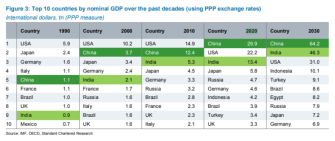China will overtake the U.S. as world’s top economy in 2020, says Standard Chartered Bank

- The Standard Chartered Bank, a British multinational banking and financial services company, recently issued a report to clients outlining projections about the world economy up until 2030.
- The report predicts Asian economies will grow significantly in the next decade, taking seven of the top 10 spots on the list of the world’s biggest economies by 2030.
- However, the researchers formed their predictions by measuring purchasing power parity at GDP, which is an approach that not all economists would use in these kinds of projections.
China is poised to overtake the United States as the world’s top economy as early as next year, according to a new report by the Standard Chartered Bank. Its analysts discovered this new status by surveying countries’ purchasing power parity (PPP) exchange rates and nominal GDP.
The shakeup will be fueled largely by a strengthening of the middle class in Asian countries, suggests the report, which was covered by MarketWatch. “The global middle class is at a tipping point,” Standard Chartered researcher Madhur Jha said in the report. “By 2020, a majority of the world population will be classified as middle class. Asia will lead the increase in middle-class populations even as middle classes stagnate in the West.”
India is also estimated to overtake the U.S. economy by 2030, largely thanks to rapid urbanization.
“India will likely be the main mover, with its trend growth accelerating to 7.8 percent by the 2020s partly due to ongoing reforms, including the introduction of a national goods and services tax (GST) and the Indian Bankruptcy Code,” Standard Chartered said.

The researchers wrote that Asia will see significant economic growth as the size of economic output begins to match the size of population.”Our long-term growth forecasts are underpinned by one key principle: countries’ share of world GDP should eventually converge with their share of the world’s population, driven by the convergence of per-capita GDP between advanced and emerging economies,” the report states.
Meanwhile, the researchers predicted that the economies of Europe and the U.S. will continue to grow, albeit at a slower rate, and that wealth inequality will continue to worsen in the U.S.
Visual Capitalist created a graphic that illustrates the report’s projections for how the world’s top economies will stack up in 2030.

If the predictions come true, countries such as Canada, France, and the U.K. would be edged out of the top 10 global economies.
Not so fast: Different measurements keep the U.S. on top
It’s important to note that the report forms its predictions by measuring PPP at GDP, while some economists would use market exchange rates instead of PPP (you can read about the differences in these economic approaches here).
“By [using simple market exchange rates] the U.S. is still today the world’s biggest economy, with a $7 trillion lead over China,” wrote Ben Chu for The Independent. “Using market exchange rates rather than PPP would also most likely change the 2030 picture. The International Monetary Fund does not forecast beyond 2023, but at this date the Fund thinks the U.S. will still be the world’s largest economy at market exchange rates and that the U.K. will still have a comfortable lead over the likes of Indonesia, Turkey, Brazil, Russia and the rest with little evidence of catchup.”
Chu continued: “The reason why China is larger than the U.S. at PPP exchange rates is because it has a population four times larger. If one measures GDP at PPP per person a very different picture emerges, with China on $18,000 and the US on $63,000.”
What’s more, the most important thing to keep in mind when considering these kinds of economic predictions is probably the fact that none of these measurements necessarily gives you an accurate picture of the standards of life in a given country. So, just because a country has a bigger economy doesn’t necessarily mean it has more freedom, higher wellbeing or better institutions.





